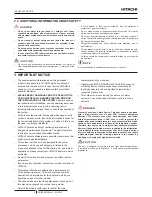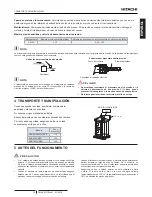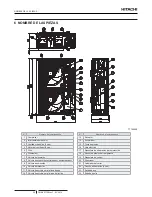
ENGLISH
8.4 REFRIGERANT CHARGE
!
C A U T I O N
•
Do not charge OXYGEN, ACETYLENE, or other flammable and
poisonous gases into the refrigerant because an explosion can occur.
It is recommended that oxygen free nitrogen be charged for these
types of tests cycle when performing a leakage test or an airtight test.
These types of gases are extremely dangerous.
•
Insulate the unions and flare-nuts at the piping connection part
completely.
• Insulate the liquid piping completely to avoid a decrease of
performance; if not, it will cause sweating on the surface of the pipe.
•
Charge refrigerant correctly. Overcharging or insufficient charging
could cause a compressor failure.
• Check for refrigerant leakage in detail. If a large refrigerant leakage
occurred, it would cause difficulty with breathing or harmful gases
would occur if a fire were being used in the room.
•
If the flare nut is tightened too hard, the flare nut may crack after a
long time and cause refrigerant leakage.
8.5 CAUTION OF THE PRESSURE BY CHECK JOINT
When the pressure is measured, use the check joint of gas stop
valve (A), and use the check joint of liquid piping (B) in the figure
below.
At that time, connect the pressure gauge according to the
following table because of high pressure side and low pressure
side changes by operation mode.
Cooling
Operation
Heating
Operation
Check Joint for Gas Stop Valve “A”
low Pressure High Pressure
Check Joint for Piping “B”
High Pressure low Pressure
Check Joint for liquid Stop Valve “C”
Exclussive for Vacuum Pump
and refrigerant Charge
?
N O T E
Be careful that refrigerant and oil do not splash to the electrical parts at
removing the charge hoses.
C
B
A
There may be gas trapped
at the “o-ring screw” part,
which may produce a
sound when released upon
removal of the cap.
However, this is not a gas
leakage.
8.6 REFRIGERANT CHARGING QUANTITY
outdoor Units has been charged with refrigerant for 15m
of actual piping length. An additional refrigerant charged is
required in systems with actual piping length longer than 15m.
1
Determine an additional refrigerant quantity according to the
following procedure, and charge it into the system.
2
record the additional refrigerant quantity to facilitate service
activities thereafter.
!
C A U T I O N
• When charging refrigerant accurately measure refrigerant to be
charged.
• Overcharging or undercharging of refrigerant can cause compressor
trouble
•
In case of actual piping length less than 5 m, consult your distributor.
W
0
(kg) is the outdoor unit refrigerant charge before shipment explained before, and it’s shown in the following table:
Model
Refrigerant charge
before shipment
(W
0
(kg))
Additional
refrigerant
charge (P)
(g/m)
Maximum
additional
charge
(kg)
rAS-4WHVnPE
3.3
60
3.9
rAS-5WHVnPE
3.4
60
3.9
rAS-6WHVnPE
3.4
60
3.9
rAS-4WHnPE
3.3
60
3.9
rAS-5WHnPE
3.4
60
3.9
rAS-6WHnPE
3.4
60
3.9
rAS-8WHnPE
5.0
(1)
10.3
rAS-10WHnPE
5.3
(1)
12.1
(1) need to be calculate
Additional refrigerant charge calculation method
1
for all units rAS-(4-6)WH(V)nPE use the following formula:
W
1
= (L-15) x P
2
for units rAS-(8-10)WHnPE
The additional refrigerant charge for rAS-(8-10)WHnPE units
must be calculated by multiplying the total piping length of each
diameter per its calculation factor according to the following
table. The result is the additional refrigerant charge subtracting
1.6 for 8 HP or 2.0 for 10 HP. (fill the table with the values)
Model
Pipe size (mm)
Additional refrigerant
charge factor (kg/m)
rAS-8WHnPE
Ø6.35
x 0.065
rAS-10WHnPE
Ø9.52
x 0.065
rEfrIGErAnT PIPInG & rEfrIGErAnT CHArGE
PMML0372B rev.1 - 03/2016
11
















































